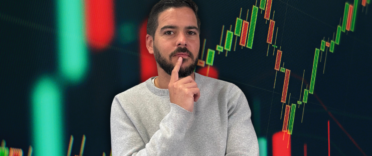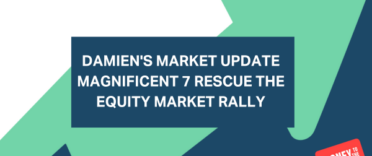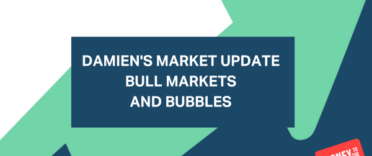Welcome to the latest episode of my monthly YouTube show where I discuss what is happening in investment markets and what to look out for. Today I talk about how equity and bond markets are breaking down.
Each show lasts between 5-10 minutes and is aimed at DIY investors (including novices) seeking contemporary analysis to help them understand how investment markets work.
Subscribe to my YouTube channel to receive my weekly analysis of investment markets or alternatively, you can listen via my weekly Midweek Markets podcast below.
Midweek Markets weekly podcast
Other ways to watch, listen and subscribe
You can listen to other episodes and subscribe to the show by searching 'Money to the Masses' on Spotify or by using the following links:
Abridged transcript - Damien's Market Update
The title of my last show was “Markets looking for direction”. The S&P 500 in America was stuck at the key 4500 level (sitting just above it 200 day moving average - which if you remember a breakdown below is usually a negative sign). In Europe the German DAX was sitting at 14160 - well below the important 14500 level while in the UK the FTSE 100 was still proving resilient sitting just below 7600, a level it needed to break above if we were going to revisit the 2018 all-time high of 7877.
Well a lot has happened since then - most of which has been negative for the typical bond/equity portfolio. Looking back, April was mostly dominated by speculation on likely changes to monetary policy from the main central banks, with inflation - and specifically energy-price inflation - grabbing the headlines. With the inflation rate hitting new highs for the US, UK and eurozone, opinion oscillated between fear that central banks would be too heavy-handed in their approach and stunt growth and, conversely, that they would not be decisive enough and that inflationary pressure would intensify.
Initially, only bond markets seemed to be paying attention to what central banks were telling us about the future direction of monetary policy - with the 10 year US treasury for example exploding higher and eventually hitting 3.2% in early May.
But after my last show, equity investors had an overdue reality check and once again we began to see equity and bond markets fall into step with one another. It means that year to date the typical 60/40 bond/equity portfolio is down -8.8%. However, the good news is my own 50k portfolio is down just 3.8% year to date - largely because I’ve divserified beyond just these two asset types.
Shrewd investors sought diversification elsewhere, with commodities one possible choice, although still subject to volatility. Overall, though, the S&P GSCI, a composite index of commodities is up over 26% year to date, far outstripping the almost wall-to-wall losses across equity indices and despite the 6% pullback we saw this week. The pullback in commodity prices this week came following concerns that China’s zero-Covid policy with its lockdowns will hit global growth. If largescale lockdowns continue China is unlikely to meet its target of 5.5% growth this year. Indeed, Chinese equities have taken a battering this year, with the CSI 300 index now down 20% year to date.
Just a few days into the the month of May and we saw intense reactions to monetary policy decisions from both the US Federal Reserve and the Bank of England. The Fed increased interest rates by 0.5% and indicated it would soon reduce its balance sheet by reducing its bond holdings. The S&P 500 leapt 3% on the back of the announcement, seemingly relieved it hadn’t actioned a more significant tightening and seeking comfort in Chairman Jay Powell’s indication that the Fed was unlikely to raise rates by 0.75% in future meetings. However, this bounce was short-lived, with the market crashing soon after. The tech-heavy Nasdaq 100 bearing the brunt of the selling once again with bitcoin following suit. The latter has fallen more than 30% in the last month alone and and broken below $30,000 - and it is a good indicator of the lack of investor risk appetite generally.
Of course, the Bank of England raised its base rate to 1% from 0.75%, and predicted inflation would rise above 10% by the autumn while the UK economy is likely to contract in 2023.
Is it any wonder that the VIX volatility index (the market fear gauge) has breached 30 (which seems to be the danger zone), up from its long-term average of 20? With explicit warnings from governments and central banks that economic conditions are going to worsen, it would perhaps be premature to assume we are over the worst of the equity market volatility. Stagflation is the buzzword in markets - which is something I’ve talked about for some time on these shows i.e. slowing growth alongside inflation. And its the interaction between market fear of inflation vs fear over a lack of economic growth that will likely change the current trends we are seeing. Right now the fear of inflation is hurting bonds more than the fear of slowing growth can support them. As soon as investors think inflation has peaked don’t be surprised if we see a rally in bonds as economic growth fears take centre stage. And if we economic growth fears emerge then don’t be surprised if we see tech stock outperform cyclical stocks once again..
Yet with so many narratives and headlines, it pays to focus on objective facts, such as index price moves, during this current market sell-off. So let me finish this episode by doing just that and giving you a few markers to look which I’ve taken from my technical analysis piece I produced last week for 80-20 Investors.
As I make this show the S&P 500 is at 4021 - having had a torrid time of late. If we break below 4000 then numerous support levels lie below every 100 points down to 3750. Many people called the bottom of the current sell-off back in March and they were clearly wrong - so nothing would surprise me right now. One thing to note is that the recent rallies have been sold out and faded by investors more quickly each time - suggesting that at the moment there is less and less conviction on any recovery. To the upside 4300 is important to break above if we are going to get excited about this market once again and only then can we thnk about the 200 day moving average and levels such as 4500 which is now a major resistance barrier.
In the UK the FTSE 100 sits at 7345 and remains in an uptrend that goes back to January 2021 and is above its 200 day moving average. If there was one equity market that you would have wanted to be in all year to avoid the carnage in global equity markets then the UK was one of them - especially with the FTSE 100s exposure to energy and oil stocks. To the upside we need to break out above the recent high of 7672 to avoid a double top pattern forming which is bearish from a technical analysis viewpoint. To the downside you should feel happier if the FTSE 100 keeps above 7150.
Finally I have to mention the pound. The strength of the pound has collapsed over the last month and once it broke down through the $1.30 the bottom fell out and we fell quickly to $1.23. On the one hand it makes your US holiday cheaper - but it has also helped buoy the FTSE 100 (don’t forget that a lot of the company earnings are overseas) but it also has buoyed your portfolio’s US equity exposure. It means that the global part of your portfolio has been insulated from the worst of the market sell-off (be it bonds and equities) thanks to a currency kicker. Of course if the dollar weaknes (its been bought as a haven play and because the US Federal Reserve has been more hawiksh than its European counterparts) then this trend could reverse and it will hurt UK investors’ portfolios as US assets will be worth less in pound terms. Also in the coming month keep an eye on the divergence between US and European equities - as a result of the divergence in monetary policy. The more dovish European Central Bank is probably one of the reasons that European equities haven’t on the whole revisited their March-lows (unlike US equities). Will this trend continue?



